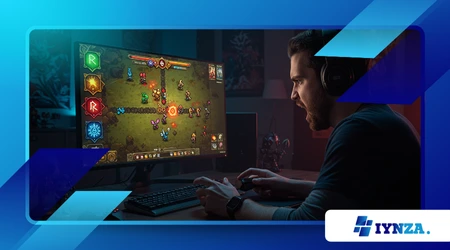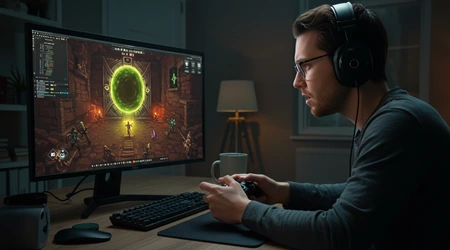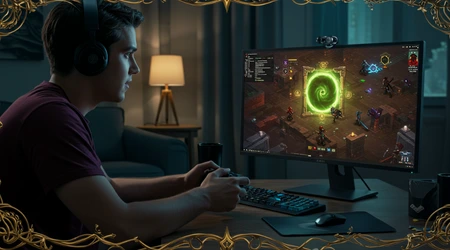Why Indie Devs Are Obsessed with Roguelikes — And Should You Be Too?

The indie gaming scene thrives on creativity, and developers are obsessed with roguelikes for their unique blend of challenge, replayability, and freedom.
Anúncios
These games, defined by procedural generation, permadeath, and skill-driven gameplay, have become a cornerstone of indie innovation.
From Hades to Slay the Spire, roguelikes dominate Steam’s indie charts, captivating players and devs alike. Why this fascination?
This article dives into the reasons behind the obsession, exploring why these games resonate so deeply and whether you, as a player or aspiring developer, should join the fray.
With a mix of accessibility, depth, and storytelling potential, roguelikes are more than a trend they’re a revolution in gaming. Let’s unpack the allure and see if it’s worth your time.
The Roguelike Recipe: Why Devs Can’t Resist
Roguelikes offer a framework that’s both restrictive and liberating. Procedural generation creates ever-changing levels, slashing development time for static designs.
Indie devs, often resource-strapped, love this efficiency. Permadeath keeps players on edge, demanding skill over memorization.
This dynamic suits small teams aiming for impactful gameplay without massive budgets. Spelunky’s randomly generated caves exemplify this each run feels fresh, yet crafted.
The genre’s flexibility is another draw. Devs blend roguelike elements with diverse mechanics, like Crypt of the NecroDancer’s rhythm-based combat.
++ The New Wave of Couch Co-Op: Retro Style, Modern Heart
This experimentation fuels creativity, letting devs carve unique niches. Small studios can compete with AAA giants by focusing on tight, replayable experiences.
The genre’s low entry barrier think Enter the Gungeon’s pixel art makes it ideal for lean teams.
Moreover, roguelikes thrive on community feedback. Early Access on Steam lets devs refine games like Dead Cells through player input.
This iterative process builds loyal fanbases, crucial for indie success. The genre’s structure encourages constant tweaks, ensuring longevity. It’s a dev’s dream: create once, iterate forever.

Players’ Addiction: The Allure of Endless Runs
Why do players keep returning to games they’re obsessed with roguelikes? The answer lies in the thrill of unpredictability.
Each run in Risk of Rain 2 offers new challenges, forcing strategic adaptation. Permadeath stings, but it teaches resilience every loss is a lesson. This cycle hooks players, as seen in Balatro’s addictive deckbuilding.
Roguelikes reward mastery over luck. Skilled players can conquer Slay the Spire’s toughest challenges, making victories deeply satisfying.
Also read: Is the NES Back? Why New Games Are Still Being Made for Old Consoles
The genre’s depth keeps players engaged for hundreds of hours. Hades blends narrative with runs, proving stories can thrive in randomization. It’s like a slot machine with soul pull the lever, but your skill shapes the outcome.
Community engagement amplifies this. Players share strategies on Reddit, like optimal Vampire Survivors builds. This social layer extends a game’s life, as fans dissect every mechanic.
Roguelikes don’t just entertain; they create cultures. For players, it’s a journey of growth, not just a game.
The Business Case: Why Roguelikes Are Indie Gold
Indie devs are obsessed with roguelikes because they’re commercially viable. A 2023 Steam report showed roguelikes among the top-selling indie genres, with Hades grossing over $200 million.
Small teams can achieve big returns with focused design. Dead Cells’s success proves polish trumps scale.
The genre’s replayability reduces marketing costs. Players spend hours mastering Into the Breach, organically spreading word-of-mouth.
Streamers amplify this Balatro exploded after Twitch coverage. Devs can launch in Early Access, refining based on feedback, minimizing financial risk. It’s a lean business model.
Read more: Exploring the Underground: The Best Indie Games You’ve Never Heard Of (Yet)
Roguelikes also suit modern gaming trends. Mobile platforms, like Wildfrost on iOS, cater to short, engaging sessions.
Cross-platform releases expand reach, as seen with Vampire Survivors. For indie devs, roguelikes offer a sustainable path to success, balancing creativity and profit.
| Game | Release Year | Key Feature | Revenue (Est.) |
|---|---|---|---|
| Hades | 2020 | Narrative-driven roguelike | $200M+ |
| Dead Cells | 2018 | Action-platformer roguelite | $50M+ |
| Slay the Spire | 2019 | Deckbuilding roguelike | $40M+ |
| Vampire Survivors | 2022 | Auto-shooter roguelite | $30M+ |
Technical Magic: Building Worlds That Shift
The technical allure of roguelikes lies in procedural generation. Devs craft algorithms to spawn unique levels, like Noita’s pixel-perfect worlds.
This reduces manual design work, letting small teams focus on mechanics. Caves of Qud’s complex systems show depth without sprawling assets.
Permadeath simplifies balance. Unlike RPGs, where power creep demands constant tuning, roguelikes reset progress. FTL: Faster Than Light balances difficulty through randomization, not intricate scripting.
Devs can iterate quickly, testing new enemies or items. It’s efficient coding with high impact.
Player-driven storytelling emerges naturally. Dwarf Fortress’s procedurally generated sagas inspire without scripted narratives.
Devs leverage this to create emergent experiences, reducing writing overhead. Roguelikes let coders and designers shine, crafting worlds that feel alive with minimal resources.
The Cultural Impact: Roguelikes as Indie Identity
Roguelikes have become synonymous with indie ethos. They embody DIY spirit—small teams like Monster Train 2’s devs create polished gems.
The genre’s accessibility fosters diversity, with games like Shiren 6 blending Japanese folklore. It’s a canvas for cultural expression.
Communities drive this identity. Binding of Isaac’s fanbase thrives on shared discoveries, like hidden items. This mirrors indie devs’ reliance on grassroots support.
Roguelikes reject AAA polish for raw creativity, resonating with players craving authenticity. They’re the punk rock of gaming.
The genre also evolves with trends. Buckshot Roulette’s horror-infused take shows roguelikes’ adaptability. Devs experiment boldly, knowing fans embrace innovation.
This cultural feedback loop fuels the obsession, making roguelikes a proving ground for indie visionaries.
Should You Be Obsessed with Roguelikes Too?
For devs, roguelikes offer a low-risk, high-reward path. A small team can craft a hit like Peglin with clever mechanics.
The genre’s flexibility allows bold experiments think Inscryption’s meta-narrative. If you’re a dev, it’s a chance to shine without millions in funding.
Players, ask yourself: do you crave challenge and discovery? Roguelikes like Hades II deliver both, blending skill and story.
They’re not for everyone permadeath frustrates some. But if you love mastering systems, the genre’s endless runs are a siren call.
The obsession isn’t blind. Roguelikes balance risk and reward, for devs and players. They’re not just games they’re ecosystems of creativity and resilience. Jump in, die a few times, and see why everyone’s obsessed with roguelikes. You might never leave.
Practical Examples: Roguelikes in Action

Imagine StarVaders, a 2025 indie hit. Its turn-based deckbuilding pits mechs against aliens. Each run tweaks your deck, forcing new strategies.
Players love its accessibility simple yet deep. Devs built it on a shoestring, using procedural generation for infinite replayability.
Or consider Slice & Dice, a dice-based roguelike. Its minimalist design hides complex choices. You roll dice to fight monsters, each face a unique ability.
Its mobile port shows how roguelikes thrive on quick sessions, perfect for indie devs targeting broad platforms.
Conclusion: Join the Roguelike Revolution
The indie world is obsessed with roguelikes for good reason. They’re a playground for creativity, efficiency, and community.
Devs craft worlds with minimal resources, while players chase mastery through endless runs. From Hades’s mythic narrative to Balatro’s poker-inspired chaos, the genre evolves, pushing boundaries. It’s not just a trend it’s a movement.
Whether you’re a dev dreaming of your next project or a player seeking a challenge, roguelikes offer something unique.
Dive into Risk of Rain 2 or Wildfrost and feel the pull. The question isn’t why they’re obsessed it’s why aren’t you? Join the revolution, and let each death teach you something new.
FAQ: Frequently Asked Questions
What makes a roguelike different from other games?
Roguelikes feature procedural generation, permadeath, and skill-driven gameplay, unlike linear games with fixed levels or heavy story focus.
Why are roguelikes so popular among indie devs?
They’re cost-effective, replayable, and flexible, allowing small teams to create deep experiences without massive budgets, as seen in Dead Cells.
Are roguelikes too hard for casual players?
Some, like NEO Scavenger, are punishing, but others, like Vampire Survivors, offer accessible entry points with gradual difficulty curves.
How do roguelikes stay fresh over time?
Procedural generation and community feedback, as with Slay the Spire’s updates, ensure varied runs and long-term engagement.
